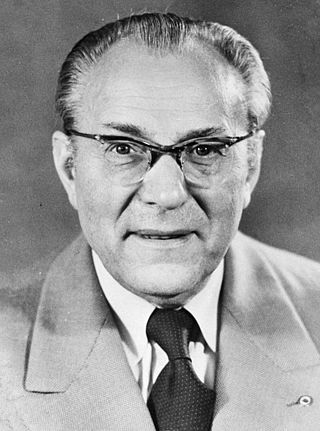
Friedrich Wilhelm Reinhold Pieck was a German communist politician who served as the chairman of the Socialist Unity Party from 1946 to 1950 and as president of the German Democratic Republic from 1949 to 1960.

Otto Emil Franz Grotewohl was a German politician who served as the first prime minister of the German Democratic Republic from its foundation in October 1949 until his death in September 1964.

Hilde Benjamin was an East German judge and Minister of Justice of the German Democratic Republic. She is most notorious for presiding over the East German show trials of the 1950s, which drew comparisons to the Nazi Party's Volksgericht show trials under Judge Roland Freisler. Hilde Benjamin is particularly known for being responsible for the politically motivated prosecution of Erna Dorn and Ernst Jennrich. In his 1994 inauguration speech German President Roman Herzog cited Hilde Benjamin as a symbol of totalitarianism and injustice, and called both her name and legacy incompatible with the German Constitution and with the rule of law.

The Communist Party of Germany (KPD) and the Social Democratic Party of Germany (SPD) merged to form the Socialist Unity Party of Germany (SED) on 21 April 1946 in the territory of the Soviet occupation zone. It is considered a forced merger. In the course of the merger, about 5,000 Social Democrats who opposed it were detained and sent to labour camps and jails.

Klaus Gysi was a journalist and publisher and a member of the French Resistance against the Nazis. After World War II, he became a politician in the German Democratic Republic, serving in the government as Minister of Culture from 1966 to 1973, and from 1979 to 1988, as the State Secretary for Church Affairs. He was a member of the Socialist Unity Party (SED) and after German Reunification, the Party of Democratic Socialism (PDS). His son is the German politician Gregor Gysi.

Walter Buchheim was an East German politician and Trade unionist.
Bruno Kaiser was a Marxist scholar of German studies who became a journalist and, during the Nazi period, a resistance activist. In his later years he became, in addition, a distinguished librarian.
Margarete "Grete" Fuchs-Keilson was a German politician and official in the Communist Party of Germany (KPD) and the Socialist Unity Party of Germany (SED).
Günter Heyden was a German professor of philosophy and a sociologist. Between 1969 and 1989 he was the director of the East Berlin basedInstitute for Marxism–Leninism.
Emmi Dölling was a Czechoslovak/German political activist (KPD/SED) and journalist.

Friedel Apelt was a German political activist, trades union official and politician (KPD/SED). During the Nazi years she participated actively in anti-fascist resistance, and spent much of the time in prison or as a concentration camp internee. After the war she was able to resume her political career in the Soviet occupation zone.
Otto Niebergall was a German politician (KPD). During the twelve Nazi years, most of which he spent abroad, he was a resistance activist.

Kurt Liebknecht was a German architect. After 1937 he pursued his career as a Soviet architect, except during a hiatus of eighteen months spent in a Soviet jail as a suspected spy.

Horst Stechbarth was an East German politician and high-ranking military officer in the National People's Army, holding the rank of Generaloberst. He was the Chief of the NVA's Landstreitkräfte and the ex officio Deputy Minister of Defense of the GDR. He was also a member of the Politbüro of the Central Committee of the ruling Socialist Unity Party of Germany (SED).
Anni Neumann is a retired East German politician who served between 1967 and 1971 as a member of the State Council of East Germany.
Heinz Rauch was a German activist and politician who fought against the fascists in the Spanish Civil War.

State elections were held in the Soviet occupation zone of Germany on 20 October 1946 to elect the state legislatures of Mecklenburg-Vorpommern, Brandenburg, Saxony, Saxony-Anhalt and Thuringia. They were the only elections held in the future territory of East Germany before the establishment of the German Democratic Republic in 1949, and the only free and fair elections in that part of Germany between 1932 and the Peaceful Revolution.

Jean Kurt Forest was a German violinist and violist, Kapellmeister and composer. He began his career as concertmaster in film orchestras conducted by Paul Dessau, then played principal viola in Frankfurt and Hamburg. Drafted to the Wehrmacht in 1942, he defected to the Red Army in 1945 and remained a prisoner of war until 1948. Back in East Berlin, he shaped musical life in the GDR in several positions, before he focused on composition from 1954, composing political songs and operas raising social awareness.

Michael Tschesno-Hell was a screenwriter and cultural official of the Deutsche Demokratische Republik.

Gerhard Wolfram was a German dramaturge, theatre director and theatre artistic director.














